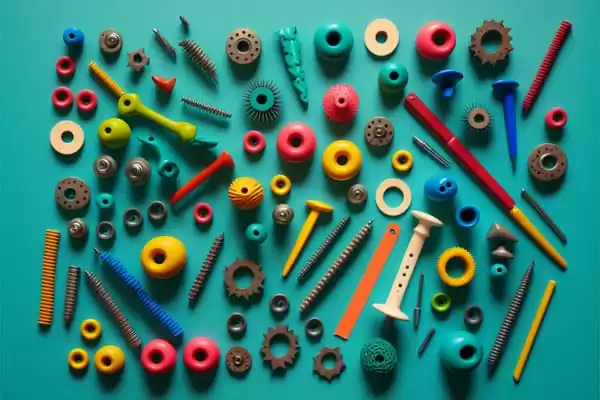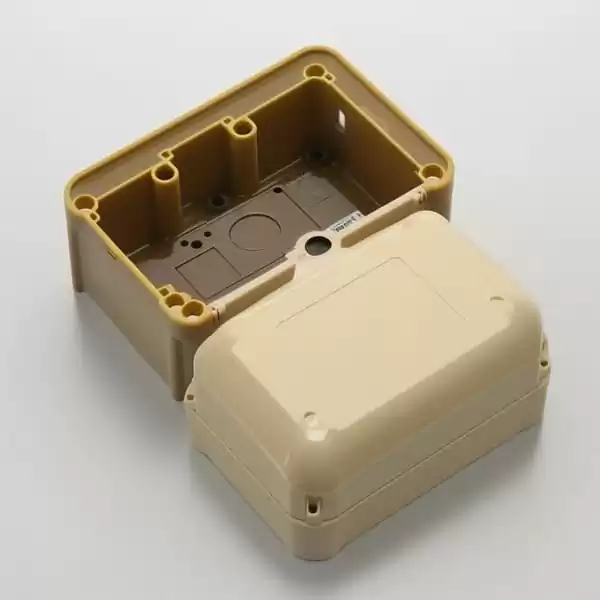Introduction
Injection molding is a highly versatile and widely used manufacturing process in which molten material is injected into a mold, creating intricate and complex shapes with precision and efficiency. The process is employed across various industries, producing a wide range of products, from tiny components to large parts.
One of the critical factors that determine the success of an injection molding project is selecting the right material for the product. The choice of material can significantly impact the product’s performance, appearance, durability, and overall cost-effectiveness. As such, careful consideration and understanding of different types of injection molding materials are essential for achieving the desired outcomes.

The purpose of this article is to delve into the world of injection molding materials, exploring the various types available and providing valuable tips for selecting the most suitable material for specific applications. By the end of this article, readers will gain insights into the key factors that influence material selection and be equipped with the knowledge to make informed decisions for their injection molding projects. Let’s begin by understanding the basics of plastic injection molding materials and its significance in the manufacturing industry.
II. Types of Materials Used in Injection Molding materials
A. Overview of the main types of materials used:
Thermoplastics:
Thermoplastics are the most common type of materials used in injection molding. They are polymers that can be melted and solidified multiple times without undergoing any significant chemical change. This characteristic makes them highly versatile and easy to process. Some popular thermoplastics include Polypropylene (PP), Polyethylene (PE), Polystyrene (PS), Polyvinyl Chloride (PVC), and Acrylonitrile Butadiene Styrene (ABS). Thermoplastics find application in various industries, such as automotive, packaging, consumer goods, and electronics.

Thermosetting Plastics:
Unlike thermoplastics, thermosetting plastics irreversibly solidify upon heating and undergo a chemical change called “curing.” Once cured, they cannot be re-melted, making them suitable for applications requiring exceptional heat resistance and dimensional stability. Examples of thermosetting plastics used in injection molding include Phenolic Resin and Epoxy Resin. These materials are commonly used in electrical components, automotive parts, and household appliances.
Elastomers:
Elastomers, also known as rubber-like materials, possess excellent elasticity and resilience. They can be categorized into two main types used in injection molding:
Thermoplastic Elastomers (TPE):
TPEs combine the properties of thermoplastics and elastomers, offering flexibility, low compression set, and good chemical resistance. They are used in applications requiring soft-touch surfaces, such as grips, seals, and gaskets.

Thermoset Elastomers:
This category includes materials like Thermoplastic Polyurethane (TPU), which exhibit excellent mechanical properties, abrasion resistance, and wide temperature ranges. TPU is commonly used in the production of medical devices, sports equipment, and industrial components.
B. Brief description of each material type and their unique properties
Thermoplastics:
Thermoplastics are known for their ability to be repeatedly melted and solidified, allowing for easy processing and recycling. They offer a wide range of mechanical properties, from flexible and impact-resistant to rigid and high-strength. Different thermoplastics have varying chemical resistance, making them suitable for various environments and applications. Their versatility, cost-effectiveness, and ease of molding make them the most commonly used materials in injection molding.
Thermosetting Plastics:
Thermosetting plastics undergo a permanent chemical change during curing, becoming rigid and offering exceptional heat resistance. Once molded and cured, they cannot be re-melted, providing dimensional stability even under high temperatures. This characteristic makes them suitable for electrical and high-temperature applications where resilience and reliability are paramount.

Elastomers:
Elastomers exhibit rubber-like properties, offering excellent elasticity and flexibility. Thermoplastic elastomers (TPEs) combine the advantages of thermoplastics and elastomers, making them easy to process and recyclable. Thermoset elastomers like Thermoplastic Polyurethane (TPU) offer high mechanical performance, abrasion resistance, and can withstand a wide range of temperatures, making them ideal for applications requiring durability and flexibility.
Understanding the unique properties of each material type allows manufacturers to select the most suitable material for their specific product requirements, ensuring optimal performance and longevity in their injection molding projects.
III. Understanding Material Properties for Material Selection
A. Factors to consider when choosing injection molding materials:
When selecting the most suitable material for an injection molding project, it is crucial to consider various material properties that directly impact the performance and functionality of the final product. Some key factors to take into account include:
Mechanical Properties:
This category encompasses a wide range of characteristics, such as tensile strength, flexibility, hardness, and toughness. The mechanical properties of a material determine its ability to withstand external forces, stresses, and deformation. For example, materials with high tensile strength and hardness are preferred for structural components, while flexibility is essential for products that require bending or stretching.
Thermal Properties:
The thermal properties of a material, such as heat resistance and temperature range, are critical for applications exposed to high or low temperatures. Heat-resistant materials like Polycarbonate and ABS are suitable for products that may encounter elevated temperatures during use, while low-temperature-resistant materials like certain elastomers are ideal for cold environments.

Electrical Properties:
For applications involving electrical components, materials with specific electrical properties are necessary. Insulating materials like Polypropylene are commonly used to prevent electrical conductivity, while conductive materials are essential for specific electronic applications.
Chemical Resistance:
Some products may come into contact with various substances or chemicals during their lifetime. In such cases, it is vital to select materials with appropriate chemical resistance to ensure the product’s integrity and longevity. For example, products used in the automotive or medical industries may require materials with high chemical resistance.
Impact Resistance:
The ability of a material to withstand impacts and loads is crucial for products subjected to mechanical forces. Impact-resistant materials, such plastic materials such as ABS and TPU, are preferred for items like protective cases, bumpers, and sports equipment.
B. Impact of material properties on the performance of the final product:
The material properties directly influence the performance, durability, and safety of the final product. Here are some examples of how specific properties impact the product’s functionality:
Strength and Toughness:
High strength and toughness ensure that the product can withstand mechanical stresses and impacts without breaking or deforming. This is crucial for products subjected to heavy loads or wear and tear.
Heat Resistance:
Products exposed to high temperatures, such as automotive components under the hood, require materials with excellent heat resistance to prevent deformation or deterioration.
Electrical Insulation:
Electrical components must be made from insulating materials to prevent short circuits or electrical hazards.
Chemical Resistance:
In industries where products are exposed to chemicals or corrosive substances, selecting materials with the appropriate chemical resistance is essential to prevent degradation or chemical reactions.
Impact Resistance:
For products like safety gear or electronics, impact resistance ensures that the product can protect against accidental drops or impacts.
By carefully considering these material properties during the injection molding material selection process, manufacturers can optimize the performance and reliability of the final product. Balancing the desired properties with other factors like cost, processing ease, and regulatory compliance is crucial to ensure a successful injection molding project.

V. Material Selection Tips for Injection Molding Projects
Selecting the right material is a critical step in ensuring the success of an injection molding project. Here are some valuable tips to consider when making the material selection:
A. Understanding the product requirements and specific application:
- Define the purpose of the product and its intended use.
- Identify the functional requirements, such as mechanical strength, flexibility, and chemical resistance.
- Consider the operating environment, including temperature variations and exposure to chemicals or UV radiation.
- Analyze any special properties needed for the product, such as electrical conductivity or flame resistance.
B. Considering volume production and cost-effectiveness:
- Evaluate the projected production volume. For high-volume production, materials that offer economies of scale may be more cost-effective.
- Compare the material costs, processing costs, and tooling costs to assess the overall cost-effectiveness of each material option.
- Factor in any secondary processes or assembly costs that may be impacted by the material choice.
C. Evaluating regulatory compliance and safety standards:
- Ensure that the chosen material complies with relevant industry regulations, safety standards, and certifications.
- Consider any specific requirements for products used in medical, automotive, or food-contact applications, where regulatory compliance is critical.
D. Addressing aesthetic and surface finish requirements:
- Determine if the product’s appearance and surface finish are crucial for its market appeal or functionality.
- Some materials offer better options for achieving specific textures, colors, or finishes, which may be essential for certain products.

E. Matching material properties to the product’s functional needs:
- Review the required mechanical properties, such as tensile strength, impact resistance, and hardness, and match them to the material’s characteristics.
- Assess the product’s thermal, electrical, and chemical resistance needs and choose materials that align with those requirements.
- Ensure that the material’s dimensional stability and creep resistance meet the product’s performance expectations.
By carefully considering these material selection tips, manufacturers can optimize the performance, durability, and cost-efficiency of their injection molding projects. Collaborating with material suppliers and conducting thorough testing and analysis can further aid in making well-informed decisions that lead to successful outcomes. Material selection plays a crucial role in shaping the product’s performance and market competitiveness, making it an essential aspect of any injection molding project.
IV. Best Plastics for Injection Molding
A. Highlighting popular injection molding materials and their applications:
Acrylonitrile Butadiene Styrene (ABS): ABS is a widely used thermoplastic known for its excellent balance of strength, impact resistance, and surface finish. Its versatility makes it suitable for a diverse range of applications, including automotive parts, consumer goods, electronic enclosures, and toys.
Polypropylene (PP): PP is a cost-effective thermoplastic with high chemical resistance and low density, making it ideal for various packaging applications, automotive components, and household items like containers and kitchenware.
Polycarbonate (PC): PC is a transparent and impact-resistant thermoplastic with high heat resistance. Its optical clarity makes it suitable for applications like safety goggles, automotive lenses, and optical discs.
Polyethylene (HDPE/LDPE): HDPE and LDPE are versatile thermoplastics widely used in packaging, containers, and plastic bags due to their excellent chemical resistance, relatively low melting points, and ease of processing.
Polyethylene Terephthalate (PET): PET is a clear and lightweight thermoplastic commonly used for beverage bottles, food containers, and synthetic fibers due to its clarity, strength, and recyclability.
Thermoplastic Polyurethane (TPU): TPU is a thermoplastic elastomer known for its exceptional mechanical properties, including high flexibility, abrasion resistance, and wide temperature range. It finds applications in medical devices, sports equipment, and industrial components.
B. Discussing the benefits and specific uses of each material:
Acrylonitrile Butadiene Styrene (ABS): ABS is favored for its good impact strength, surface finish, and ease of processing. It is commonly used in manufacturing automotive dashboards, bumper covers, electrical housings, and consumer electronics.
Polypropylene (PP): PP’s chemical resistance, lightweight, and relatively low cost make it an excellent choice for packaging materials, containers, automotive components, and household items like dishwasher-safe food containers.
Polycarbonate (PC): PC’s optical clarity and high impact resistance make it suitable for applications requiring transparency and durability, such as safety goggles, face shields, automotive headlamp lenses, and optical discs.
Polyethylene (HDPE/LDPE): HDPE’s rigidity and LDPE’s flexibility make them suitable for various applications of plastic material. High density polyethylene is used in containers, pipes, and household products, while LDPE is used for plastic bags, shrink wraps, and flexible tubing.

Polyethylene Terephthalate (PET): PET’s transparency, lightweight, and recyclability make it a popular choice for beverage bottles, food containers, and apparel fibers like polyester.
Thermoplastic Polyurethane (TPU): TPU’s combination of flexibility, abrasion resistance, and wide temperature range makes it ideal for applications like medical tubing, sports shoe soles, smartphone cases, and automotive seals.
Each of these materials offers unique advantages, and the selection should be based on the specific requirements of the product. Factors such as mechanical properties, environmental conditions, regulatory compliance, and cost-effectiveness should be carefully considered to ensure the best match between the material and the intended application in injection molding projects.
V. Material Selection Tips for Injection Molding Projects
Selecting the right material is a critical step in ensuring the success of an injection molding project. Here are some valuable tips to consider when making the material selection:
A. Understanding the product requirements and specific application:
- Define the purpose of the product and its intended use.
- Identify the functional requirements, such as mechanical strength, flexibility, and chemical resistance.
- Consider the operating environment, including temperature variations and exposure to chemicals or UV radiation.
- Analyze any special properties needed for the product, such as electrical conductivity or flame resistance.
B. Considering volume production and cost-effectiveness:
- Evaluate the projected production volume. For high-volume production, materials that offer economies of scale may be more cost-effective.
- Compare the material costs, processing costs, and tooling costs to assess the overall cost-effectiveness of each material option.
- Factor in any secondary processes or assembly costs that may be impacted by the material choice.
C. Evaluating regulatory compliance and safety standards:
- Ensure that the chosen material complies with relevant industry regulations, safety standards, and certifications.
- Consider any specific requirements for products used in medical, automotive, or food-contact applications, where regulatory compliance is critical.
D. Addressing aesthetic and surface finish requirements:
- Determine if the product’s appearance and surface finish are crucial for its market appeal or functionality.
- Some materials offer better options for achieving specific textures, colors, or finishes, which may be essential for certain products.
E. Matching material properties to the product’s functional needs:
- Review the required mechanical properties, such as tensile strength, impact resistance, and hardness, and match them to the material’s characteristics.
- Assess the product’s thermal, electrical, and chemical resistance needs and choose materials that align with those requirements.
- Ensure that the material’s dimensional stability and creep resistance meet the product’s performance expectations.

By carefully considering these material selection tips, manufacturers can optimize the performance, durability, and cost-efficiency of their injection molding projects. Collaborating with material suppliers and conducting thorough testing and analysis can further aid in making well-informed decisions that lead to successful outcomes. Material selection plays a crucial role in shaping the product’s performance and market competitiveness, making it an essential aspect of any injection molding project.
Conclusion
In conclusion, material selection is a pivotal aspect of the injection molding process, influencing the success, performance, and market competitiveness of the final product. By understanding the specific product requirements and considering various factors, manufacturers can make informed decisions when choosing the most suitable material for their injection molding projects.
The importance of material selection lies in its direct impact on the product’s functionality, durability, and overall quality. Selecting the right material ensures that the product meets the desired mechanical, thermal, and chemical properties, making it well-suited for its intended application. Moreover, choosing the appropriate material contributes to the product’s safety and compliance with relevant regulations, especially in industries like medical devices and automotive components.
It is crucial to emphasize the significance of matching material properties to the functional needs of the product. Whether it’s selecting a material with high impact resistance for safety equipment or choosing a material with excellent chemical resistance for harsh environments, making the right material choice can significantly enhance the product’s performance and longevity.
Additionally, the material selection process has a direct impact on the cost-effectiveness of the injection molding project. By considering production volume and material costs, manufacturers can optimize their resources and achieve better economies of scale, leading to more competitive pricing for the end product.
In conclusion, successful material selection is not only about finding a material that meets the technical requirements but also about considering the aesthetics, surface finish, and market appeal of the product. Collaborating with material suppliers, conducting thorough testing, and seeking expert advice are valuable steps to ensure the best possible material choice.
As manufacturers navigate the world of injection molding materials, they are encouraged to make well-informed decisions based on their product’s specific needs and performance expectations. By doing so, they can harness the full potential of injection molding materials, ultimately leading to a successful product that stands out in the market and meets customer demands. Remember, choosing the right material is not just a decision but an investment in the product’s success and competitiveness in the ever-evolving manufacturing landscape.






